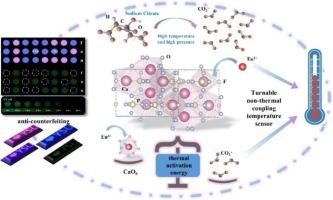Tunable thermal activation energy of paramagnetic defects and Eu3+ in organic auxiliary modified fluorapatite for optical applications
IF 13.2
1区 工程技术
Q1 ENGINEERING, CHEMICAL
引用次数: 0
Abstract
Luminescence thermometry is a reliable temperature indicator by the way of spectral responses to thermal stimuli. It is of great significance to realize the flexible adjustment of its high thermal sensitivity for broadening its application range. Herein, we adopt the thermal activation energy of dual emission centers for the modulation of fluorapatite-type high-sensitivity luminescence thermometers. The organic auxiliary modified compound, Eu3+ doped Ca5(PO4)3F (CAF): sodium citrate (SC) matrix, is synthesized by hydrothermal method. On this basis, metal ions Sr2+ and Ba2+ with different radii are introduced to enhance the luminescence of CO2∙- paramagnetic defects by crystal field distortion and morphology adjustment. The change of local crystal field environment symmetry is characterized by the luminescence properties of Eu3+. Specifically, the high local environmental symmetry is beneficial to gain excellent thermal stability of the CO2∙- with big thermal activation energy. Mechanistic investigations reveal that thermal activation energy of CO2∙- and Eu3+ as key parameter can adjust the relative sensitivity (Sr) of the thermos-sensitive material, yielding the maximum Sr and temperature uncertainty (δT) of 1.92 %K−1 at 298 K and 0.23 K at 453 K, respectively. Besides, Carbon dots (CDs) are introduced to form other compound and further verify the feasibility of the above sensitivity adjustment. Meanwhile, a flexible-film with long afterglow information encoding is also achieved for optical anti-counterfeiting. This work not only provides a new strategy for the design of tunable fluorapatite luminescent thermometers, but also constructs promising anti-counterfeiting candidate materials.

光学用有机辅助改性氟磷灰石中顺磁缺陷和Eu3+的热活化能可调
发光测温法是一种可靠的温度指示方法,通过光谱对热刺激的响应。实现对其高热敏度的灵活调节对扩大其应用范围具有重要意义。本文采用双发射中心热活化能调制氟磷灰石型高灵敏度发光温度计。采用水热法合成了Eu3+掺杂Ca5(PO4)3F (CAF):柠檬酸钠(SC)基质的有机辅助改性化合物。在此基础上,引入不同半径的金属离子Sr2+和Ba2+,通过晶体场畸变和形态调整增强CO2∙-顺磁缺陷的发光能力。Eu3+的发光特性表征了局部晶体场环境对称性的变化。其中,较高的局部环境对称性有利于获得具有较大热活化能的CO2∙-的优良热稳定性。机理研究表明,作为关键参数的CO2∙-和Eu3+的热活化能可以调节热敏材料的相对灵敏度(Sr),在298 K和453 K时,Sr和温度不确定度(δT)的最大值分别为1.92% K−1和0.23 K。此外,引入碳点(CDs)形成其他化合物,进一步验证了上述灵敏度调整的可行性。同时,还实现了具有长余辉信息编码的柔性薄膜,用于光学防伪。这项工作不仅为可调谐氟磷灰石发光温度计的设计提供了新的策略,而且还构建了有前途的防伪候选材料。
本文章由计算机程序翻译,如有差异,请以英文原文为准。
求助全文
约1分钟内获得全文
求助全文
来源期刊

Chemical Engineering Journal
工程技术-工程:化工
CiteScore
21.70
自引率
9.30%
发文量
6781
审稿时长
2.4 months
期刊介绍:
The Chemical Engineering Journal is an international research journal that invites contributions of original and novel fundamental research. It aims to provide an international platform for presenting original fundamental research, interpretative reviews, and discussions on new developments in chemical engineering. The journal welcomes papers that describe novel theory and its practical application, as well as those that demonstrate the transfer of techniques from other disciplines. It also welcomes reports on carefully conducted experimental work that is soundly interpreted. The main focus of the journal is on original and rigorous research results that have broad significance. The Catalysis section within the Chemical Engineering Journal focuses specifically on Experimental and Theoretical studies in the fields of heterogeneous catalysis, molecular catalysis, and biocatalysis. These studies have industrial impact on various sectors such as chemicals, energy, materials, foods, healthcare, and environmental protection.
 求助内容:
求助内容: 应助结果提醒方式:
应助结果提醒方式:


